TEM Image Analysis and Simulation Physics for Two-Step Recrystallization of Discretely Amorphized C3H5-Molecular-Ion-Implanted Silicon Substrate Surface
Abstract
:1. Introduction
2. Experimental Methods
2.1. Experimental Sample Preparation and Evaluation Procedure
2.2. Analysis Procedure for Plan-View TEM Images
2.3. TCAD Process Simulation Procedure
3. Results and Discussion
3.1. Results of Analyzing Plan-View TEM Image of Si Substrate Surface after C3H5 Molecular Ion Implantation and Subsequent Thermal Annealing Treatment
3.2. TCAD Process Simulation Results after C3H5 Molecular Ion Implantation and Subsequent Thermal Annealing
3.3. Overall Two-Step Recrystallization Model of the Discretely Amorphized C3H5-Molecular-Ion-Implanted Si Substrate Surface
4. Conclusions
Author Contributions
Funding
Data Availability Statement
Acknowledgments
Conflicts of Interest
References
- Russo, F.; Nardone, G.; Polignano, M.L.; D’Ercole, A.; Pennella, F.; Felice, M.D.; Monte, A.; Matarazzo, A.; Moccia, G.; Polsinelli, G.; et al. Dark Current Spectroscopy of Transition Metals in CMOS Image Sensors. ECS J. Solid State Sci. Technol. 2017, 6, 217–226. [Google Scholar] [CrossRef]
- Domengie, F.; Regolini, J.L.; Bauza, D. Study of metal contamination in CMOS image sensors by dark-current and deep-level transient spectroscopies. J. Electron. Mater. 2010, 39, 625–629. [Google Scholar] [CrossRef]
- Ohtani, A.; Kaneda, T. Analysis of residual image in CMOS image sensor 2. In Proceedings of the Extended Abstracts of the 77th Japan Society of Applied Physics and Related Societies Autumn Meeting, Niigata, Japan, 13–16 September 2016; p. 14p-P6-11. (In Japanese). [Google Scholar]
- Tournier, A.; Leverd, F.; Favennec, L.; Perrot, C.; Pinzelli, L.; Gatefait, M.; Cherault, N.; Jeanjean, D.; Carrere, J.-P.; Hirigoyen, F.; et al. Pixel-to-pixel isolation by deep trench technology: Application to CMOS image sensor. In Proceedings of the 2011 International Image Sensor Workshop (IISW), Hokkaido, Japan, 8–11 June 2011; pp. 12–15. [Google Scholar]
- Kwon, H.I.; Kang, I.M.; Park, B.G.; Lee, J.D.; Park, S.S. The analysis of dark signals in the CMOS APS imagers from the characterization of test structures. IEEE Trans. Electron Devices 2004, 51, 178–184. [Google Scholar] [CrossRef]
- Kurita, K.; Kadono, T.; Okuyama, R.; Onaka-Masada, A.; Shigematsu, S.; Kobayashi, K.; Suzuki, A.; Okuda, H.; Koga, Y. Silicon Wafer Gettering Design for Advanced CMOS Image Sensors Using Hydrocarbon Molecular Ion Implantation: A Review. IEEE J. Electron Devices Soc. 2021, 10, 720–727. [Google Scholar] [CrossRef]
- Kurita, K.; Kadono, T.; Okuyama, R.; Hirose, R.; Onaka-Masada, A.; Koga, Y.; Okuda, H. Proximity gettering of C3H5 carbon cluster ion-implanted silicon wafers for CMOS image sensors: Gettering effects of transition metal, oxygen, and hydrogen impurities. Jpn. J. Appl. Phys. 2016, 55, 121301. [Google Scholar] [CrossRef]
- Kurita, K.; Kadono, T.; Okuyama, R.; Shigematsu, S.; Hirose, R.; Onaka-Masada, A.; Koga, Y.; Okuda, H. Proximity gettering technology for advanced CMOS image sensors using carbon cluster ion-implantation technique: A review. Phys. Status Solidi A 2017, 214, 1700216. [Google Scholar] [CrossRef]
- Okuda, H.; Okuyama, R.; Iwanaga, T.; Kadono, T.; Hirose, R.; Koga, Y.; Kurita, K. Proximity Gettering of Carbon Cluster Ion Irradiated Silicon Wafers (3)—Oxygen Diffusion Behavior after Epitaxial Growth. In Proceedings of the Extended Abstracts of the 62nd Japan Society of Applied Physics and Related Societies Spring Meeting, Kanagawa, Japan, 11–14 March 2015; p. 12p-A18-15. (In Japanese). [Google Scholar]
- Okuyama, R.; Masada, A.; Kadono, T.; Hirose, R.; Koga, Y.; Okuda, H.; Kurita, K. Trapping and diffusion kinetic of hydrogen in carbon-cluster ion-implantation projected range in Czochralski silicon wafers. Jpn. J. Appl. Phys. 2017, 56, 025601. [Google Scholar] [CrossRef]
- Kadono, T.; Okuyama, R.; Onaka-Masada, A.; Hirose, R.; Shigematsu, S.; Koga, Y.; Okuda, H.; Kurita, K. Effect of hydrocarbon molecular ion size for amorphous region formation analyzed by X-ray photoelectron spectroscopy. Jpn. J. Appl. Phys. 2020, 59, 025510. [Google Scholar] [CrossRef]
- Kobayashi, K.; Okuyama, R.; Kadono, T.; Onaka-Masada, A.; Hirose, R.; Shigematsu, S.; Suzuki, A.; Koga, Y.; Kurita, K. Re-crystallization Behavior of Amorphous Layer in Hydrocarbon Molecular Ion Implanted Region Using Flash Lamp Annealing. In Proceedings of the 2018 22nd International Conference on Ion Implantation Technology (IIT), Würzburg, Germany, 16–21 September 2018; pp. 357–360. [Google Scholar]
- Kobayashi, K.; Okuyama, R.; Kadono, T.; Onaka-Masada, A.; Hirose, R.; Suzuki, A.; Koga, Y.; Kurita, K. Recrystallization model of discrete amorphous regions in C3H5-molecular-ionimplanted silicon substrate surface analyzed by X-ray photoelectron spectroscopy. Jpn. J. Appl. Phys. 2022, 61, 115501. [Google Scholar] [CrossRef]
- Kobayashi, K.; Okuyama, R.; Kadono, T.; Onaka-Masada, A.; Hirose, R.; Suzuki, A.; Koga, Y.; Kurita, K.; Sueoka, K. Kinetic Monte Carlo Simulations for Recrystallization Process of Discrete Amorphous Regions in C3H5-Molecular-Ion-Implanted Silicon Substrate Surface. In Proceedings of the 2023 21st International Workshop on Junction Technology (IWJT), Kyoto, Japan, 8–9 June 2023; pp. 140–143. [Google Scholar]
- Kobayashi, K.; Okuyama, R.; Kadono, T.; Onaka-Masada, A.; Hirose, R.; Suzuki, A.; Koga, Y.; Sueoka, K.; Kurita, K. Two-and three-dimensional recrystallization of discrete amorphous in C3H5-molecular-ion-implanted silicon surface analyzed by TCAD simulation. ECS J. Solid State Sci. Technol. 2023. submitted. [Google Scholar]
- Johnson, W.A.; Mehl, R.F. Reaction Kinetics in Processes of Nucleation and Growth. Trans. Am. Inst. Min. Metall. Eng. 1939, 135, 416–442. [Google Scholar]
- Avrami, M. Kinetics of Phase Change. I General theory. J. Chem. Phys. 1939, 7, 1103–1112. [Google Scholar] [CrossRef]
- Avrami, M. Kinetics of Phase Change. II transformation-time relations for random distribution of nuclei. J. Chem. Phys. 1940, 8, 212–224. [Google Scholar] [CrossRef]
- Avrami, M. Granulation, phase change, and microstructure kinetics of phase change. III. J. Chem. Phys. 1941, 9, 177–184. [Google Scholar] [CrossRef]
- Yamamoto, M. Kinetics of Material; Uchida Rokakuho: Tokyo, Japan, 2015; Chapter 3; pp. 145–148. [Google Scholar]
- Yoo, W.S.; Ishigaki, T.; Kang, K. Image processing software assisted quantitative analysis of various digital images in process monitoring, process control and material characterization. In Proceedings of the 2017 International Conference on Frontiers of Characterization and Metrology for Nanoelectronics (ICFCMN), Monterey, CA, USA, 20–23 March 2017; pp. 276–279. [Google Scholar]
- Synopsys Sentaurus Process User’s Manual, Release p-2019.03; Synopsys Inc.: Zurich, Switzerland, 2019; pp. 104–128, 433–442, 455–464.
- Tian, S. Predictive Monte Carlo ion implantation simulator from sub-keV to above 10 MeV. J. Appl. Phys. 2003, 93, 5893–5904. [Google Scholar] [CrossRef]
- Posselt, M.; Schmidt, B.; Murthy, C.S.; Feudel, T.; Suzuki, K. Modeling of Damage Accumulation during Ion Implantation into Single-Crystalline Silicon. J. Electrochem. Soc. 1997, 144, 1495–1504. [Google Scholar] [CrossRef]
- Bragado, M.; Borges, R. Kinetic Monte Carlo simulation for semiconductor processing: A review. Prog. Mater. Sci. 2018, 92, 1–32. [Google Scholar] [CrossRef]
- Battaglia, A.; Priolo, F.; Rimini, E.; Ferla, G. Ion-induced annealing and amorphization of isolated damage clusters in Si. Appl. Phys. Lett. 1990, 56, 2622–2624. [Google Scholar] [CrossRef]
- Donnelly, S.E.; Bircher, R.C.; Vishnyakov, V.M.; Carter, G. Annealing of isolated amorphous zones in silicon. Appl. Phys. Lett. 2003, 82, 1860–1862. [Google Scholar] [CrossRef]
- Caturla, M.-J.; Diaz de la Rubia, T.; Marques, L.A.; Gilmer, G.H. Ion-beam processing of silicon at keV energies: A molecular-dynamics study. Phys. Rev. B. 1996, 54, 16683. [Google Scholar] [CrossRef]
- Mok, K.R.C.; Benistant, F.; Jaraiz, M.; Rubio, J.E.; Castrillo, P.; Pinacho, R.; Srinivasan, M.P. Comprehensive model of damage accumulation in silicon. J. Appl. Phys. 2008, 103, 014911. [Google Scholar] [CrossRef]
- Pelaz, L.; Marques, L.A.; Aboy, M.; Barbolla, J.; Gilmer, G.H. Atomistic modeling of amorphization and recrystallization in silicon. Appl. Phys. Lett. 2003, 82, 2038–2040. [Google Scholar] [CrossRef]
- López, P.; Pelaz, L.; Marqués, L.A.; Santos, I. Atomistic analysis of the annealing behavior of amorphous regions in silicon. J. Appl. Phys. 2007, 101, 093518. [Google Scholar] [CrossRef]
- Masaki, Y.; LeComber, P.G.; Fitzgerald, A.G. Solid phase crystallization of thin films of Si prepared by plasma-enhanced chemical vapor deposition. J. Appl. Phys. 1993, 74, 129–134. [Google Scholar] [CrossRef]
- Sezgin, M.; Sankur, B. Survey over image thresholding techniques and quantitative performance evaluation. J. Electron. Imaging. 2004, 13, 146–168. [Google Scholar]
- Otsu, N. A Threshold Selection Method from Gray-Level Histograms. IEEE Trans. Syst. Man Cybern. 1979, 9, 62–66. [Google Scholar] [CrossRef]
- Edmondson, P.D.; Riley, D.J.; Birtcher, R.C.; Donnelly, S.E. Amorphization of crystalline Si due to heavy and light ion irradiation. J. Appl. Phys. 2009, 106, 043505. [Google Scholar] [CrossRef]
- Csepregi, L.; Kennedy, E.F.; Mayer, J.W.; Sigmon, T.W. Substrate-orientation dependence of the epitaxial regrowth rate from Si-implanted amorphous Si. J. Appl. Phys. 1978, 49, 3906–3911. [Google Scholar] [CrossRef]
- Spaepen, F.; Turnbull, D. Laser Annealing of Semiconductor; Academic Press: New York, NY, USA, 1982; Chapter 2; pp. 28–31. [Google Scholar]
- Williams, J.S.; Elliman, R.G. Role of electronic processes in epitaxial recrystallization of amorphous semiconductors. Phys. Rev. Lett. 1983, 51, 1069. [Google Scholar] [CrossRef]
- Lu, G.-W.; Nygren, E.; Aziz, M.J. Pressure-enhanced crystallization kinetics of amorphous Si and Ge: Implications for point-defect mechanisms. J. Appl. Phys. 1991, 70, 5323–5345. [Google Scholar] [CrossRef]
- Priolo, F.; Battaglia, A.; Nicotra, R.; Rimini, E. Low-temperature reordering in partially amorphized Si crystals. Appl. Phys. Lett. 1990, 57, 768–770. [Google Scholar] [CrossRef]
- Donnelly, S.E.; Birtcher, R.C.; Vishnyakov, V.M.; Edmondson, P.D.; Carter, G. Anomalous annealing behavior of isolated amorphous zones in silicon. Nucl. Instr. Meth. Phys. Res. B 2006, 242, 595–597. [Google Scholar] [CrossRef]
- El-Ghor, M.K.; Holland, O.W.; White, C.W.; Pennycook, S.J. Structural characterization of damage in Si (100) produced by MeV Si+ ion implantation and annealing. J. Mater. Res. 1990, 5, 352–359. [Google Scholar] [CrossRef]
- Holland, O.W.; White, C.W.; El-Ghor, M.K.; Budai, J.D. MeV, self-ion implantation in Si at liquid nitrogen temperature; a study of damage morphology and its anomalous annealing behavior. J. Appl. Phys. 1990, 68, 2081–2086. [Google Scholar] [CrossRef]
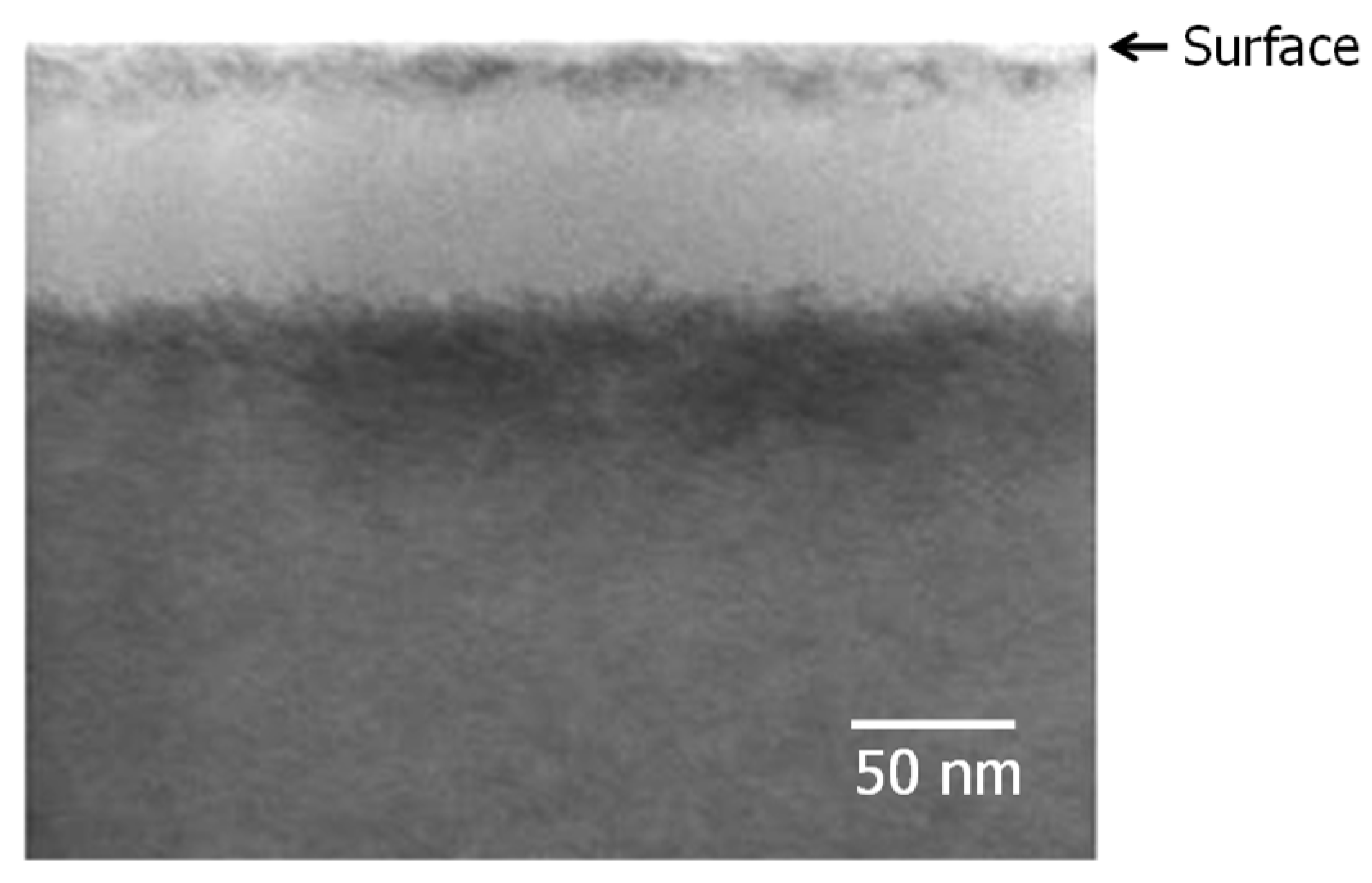
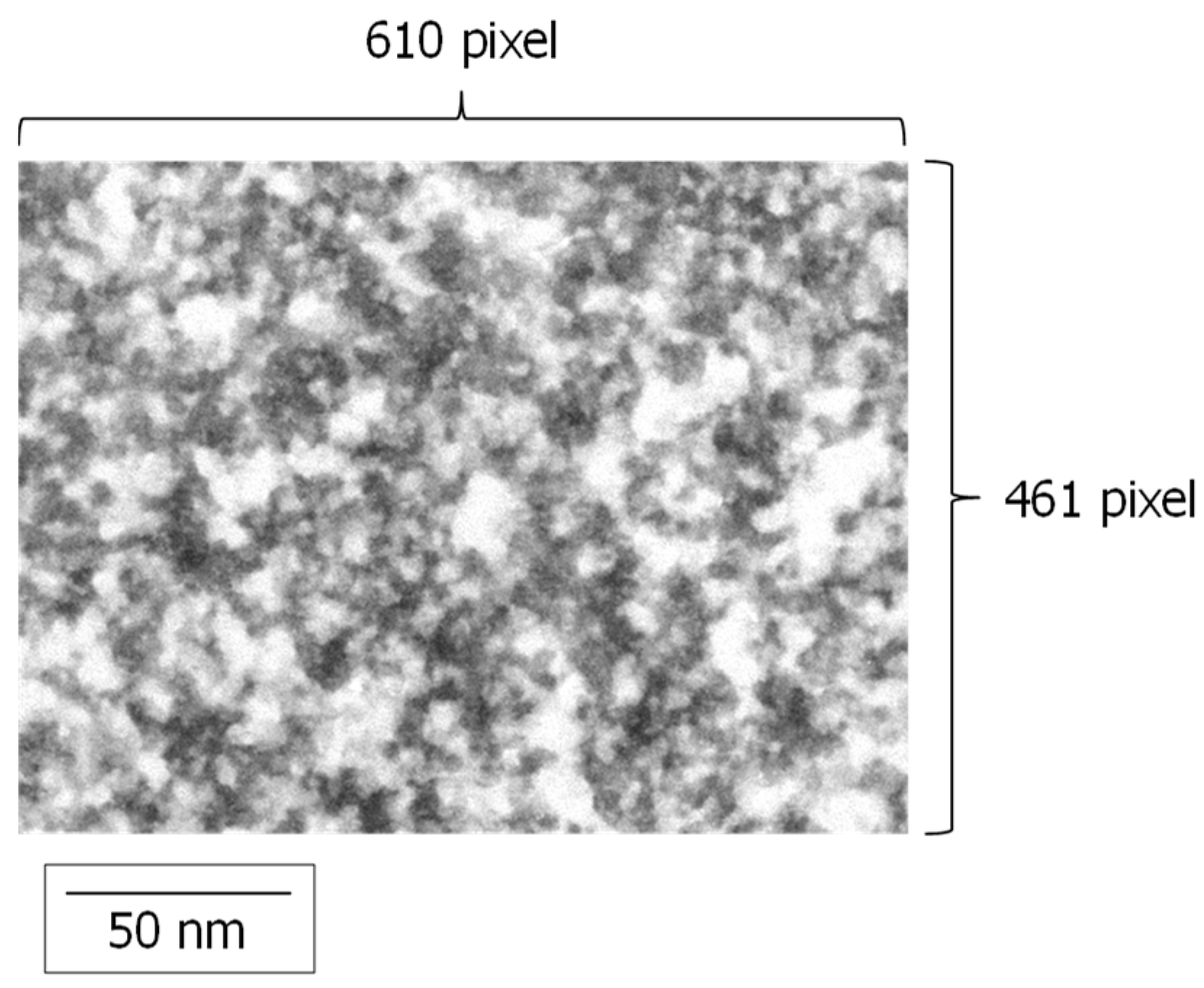
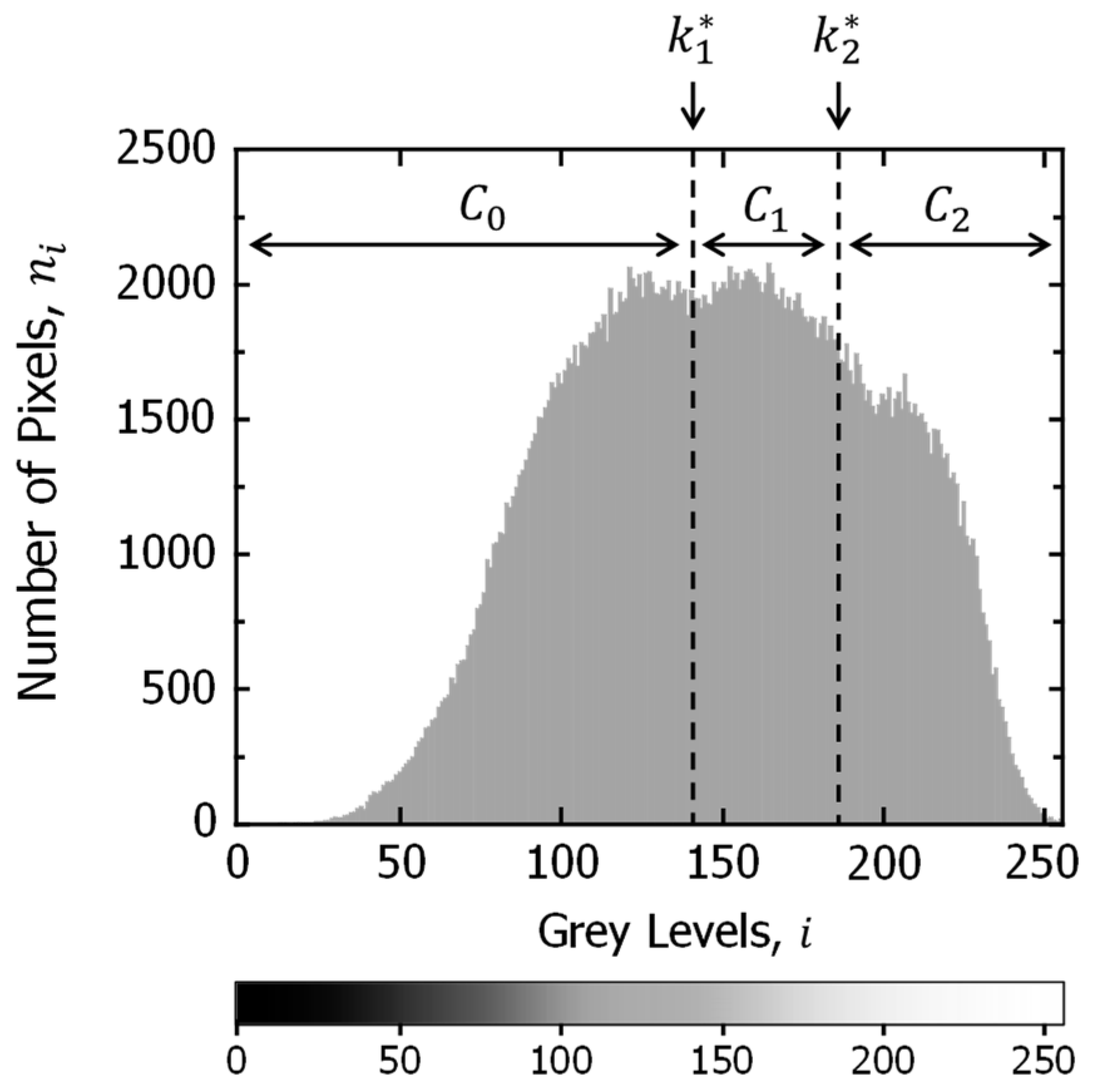




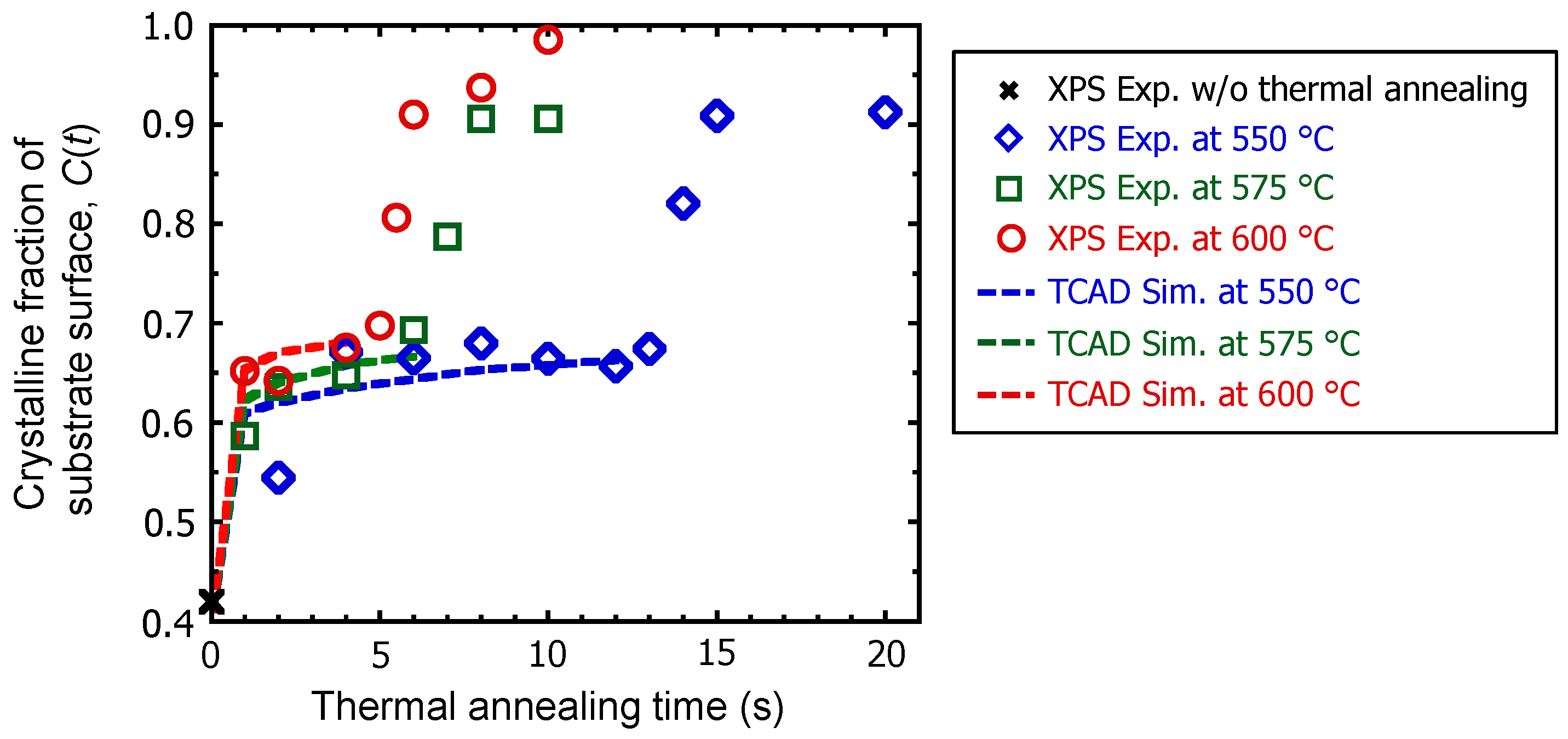
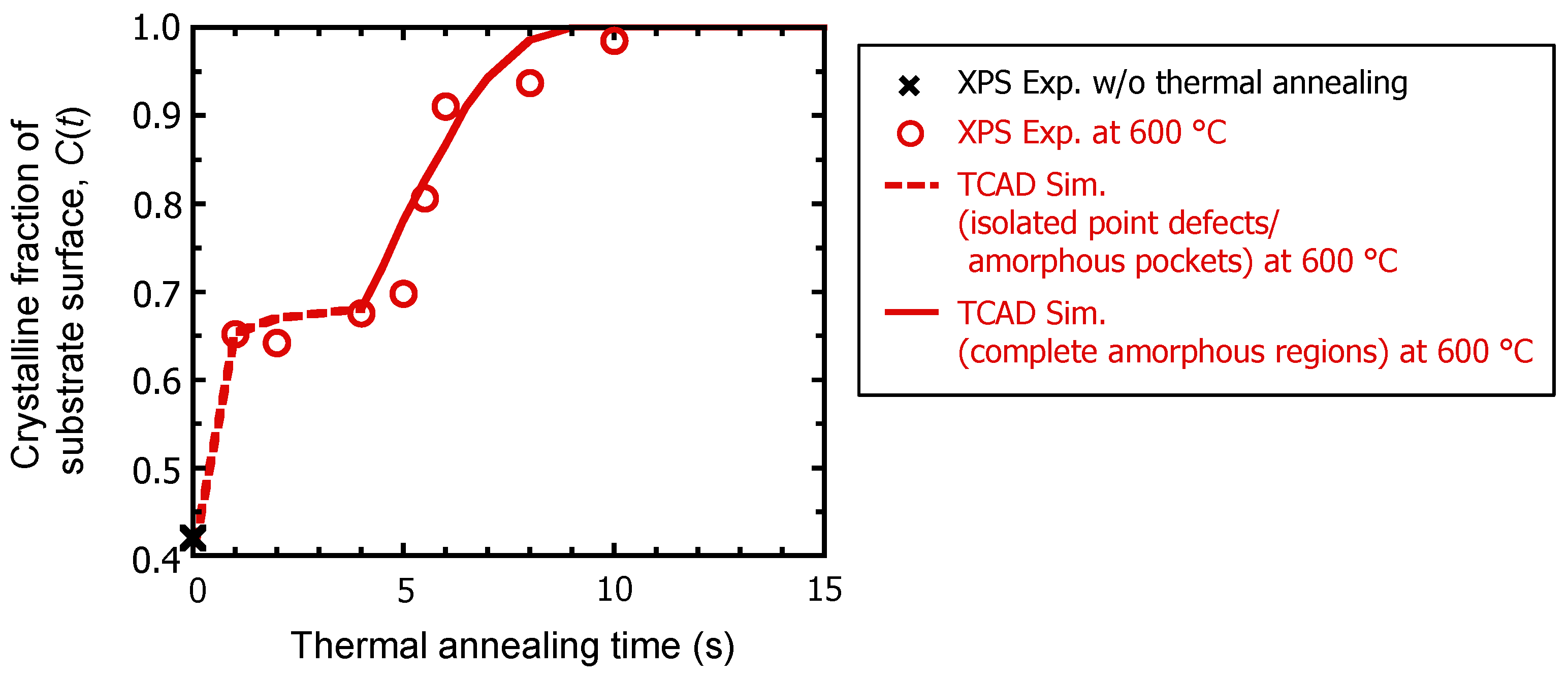
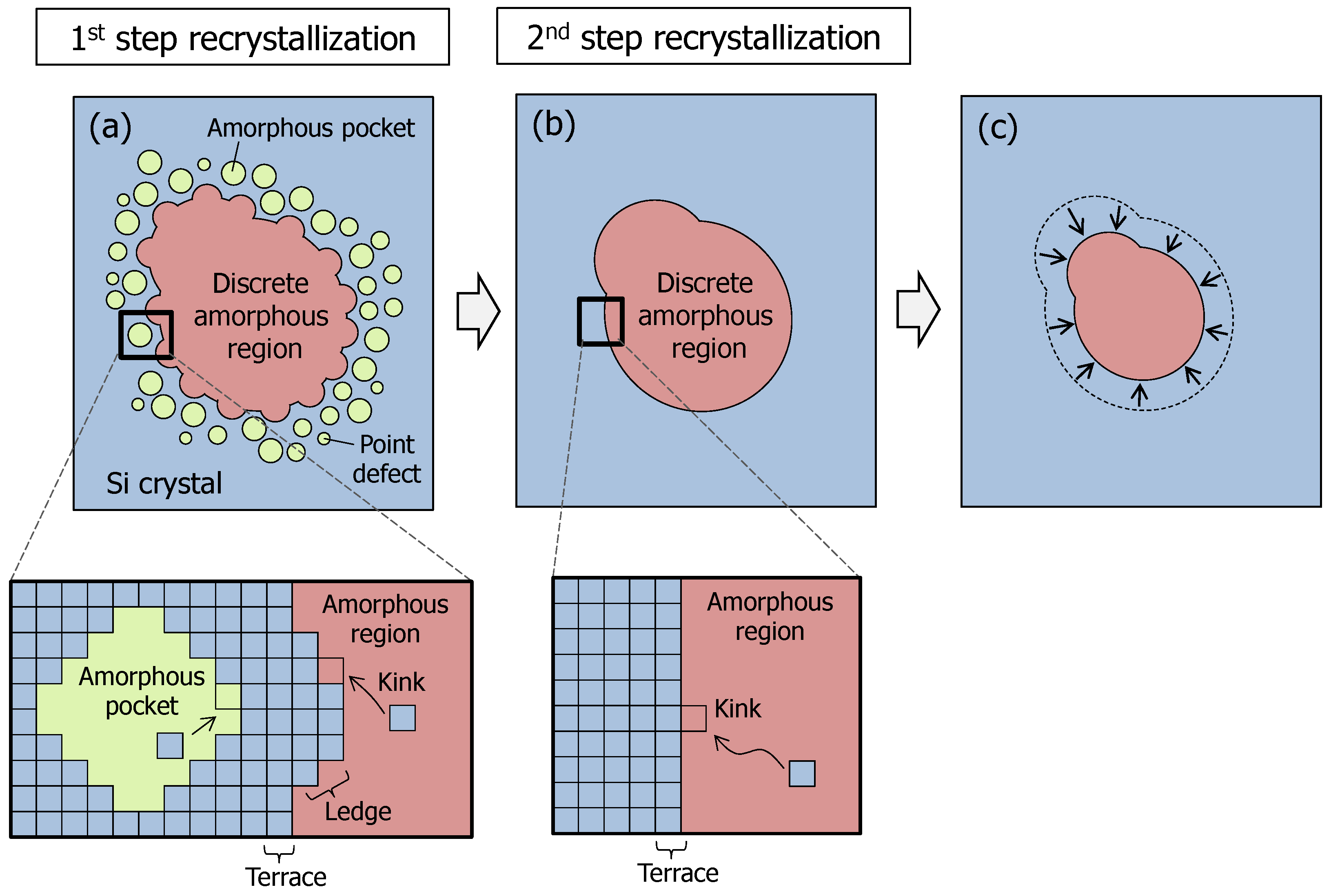
| Process | Parameter | Input Value | Unit |
|---|---|---|---|
| Amorphization in MC ion implantation | |||
| Recombination of amorphous pockets (Equation (2)) | |||
| Recrystallization of amorphous regions (Equation (3)) | |||
Disclaimer/Publisher’s Note: The statements, opinions and data contained in all publications are solely those of the individual author(s) and contributor(s) and not of MDPI and/or the editor(s). MDPI and/or the editor(s) disclaim responsibility for any injury to people or property resulting from any ideas, methods, instructions or products referred to in the content. |
© 2024 by the authors. Licensee MDPI, Basel, Switzerland. This article is an open access article distributed under the terms and conditions of the Creative Commons Attribution (CC BY) license (https://creativecommons.org/licenses/by/4.0/).
Share and Cite
Kobayashi, K.; Okuyama, R.; Kadono, T.; Onaka-Masada, A.; Hirose, R.; Suzuki, A.; Koga, Y.; Sueoka, K.; Kurita, K. TEM Image Analysis and Simulation Physics for Two-Step Recrystallization of Discretely Amorphized C3H5-Molecular-Ion-Implanted Silicon Substrate Surface. Crystals 2024, 14, 112. https://doi.org/10.3390/cryst14020112
Kobayashi K, Okuyama R, Kadono T, Onaka-Masada A, Hirose R, Suzuki A, Koga Y, Sueoka K, Kurita K. TEM Image Analysis and Simulation Physics for Two-Step Recrystallization of Discretely Amorphized C3H5-Molecular-Ion-Implanted Silicon Substrate Surface. Crystals. 2024; 14(2):112. https://doi.org/10.3390/cryst14020112
Chicago/Turabian StyleKobayashi, Koji, Ryosuke Okuyama, Takeshi Kadono, Ayumi Onaka-Masada, Ryo Hirose, Akihiro Suzuki, Yoshihiro Koga, Koji Sueoka, and Kazunari Kurita. 2024. "TEM Image Analysis and Simulation Physics for Two-Step Recrystallization of Discretely Amorphized C3H5-Molecular-Ion-Implanted Silicon Substrate Surface" Crystals 14, no. 2: 112. https://doi.org/10.3390/cryst14020112







